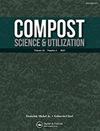堆肥中单一和复合除草剂对敏感作物青豆、黄瓜和番茄生长的影响
IF 0.9
4区 农林科学
Q3 ECOLOGY
引用次数: 5
摘要
摘要堆肥在中国蔬菜生产中经常使用,但用于这些堆肥的原料来源多种多样,其中一些可能含有除草剂残留。为了评估除草剂对用作生长基质的堆肥产品的风险,我们选择了三种敏感的蔬菜作物:绿豆、番茄和黄瓜,并将它们放在不含除草剂的堆肥中种植(CK),添加吡喃氯(C1,0.001μg/g)、三氟林(C2,0.05μg/g。在CM处理中,所有除草剂的添加浓度为单一处理的1/10。用0、5、10和20%的堆肥对培养基进行改良。45天后测定出苗率、幼苗活力指数(SVI)和各种生长指数(茎高、茎径、叶面积、根干重和植物生物量)。结果表明:不加除草剂的堆肥(CK)对植物出苗(绿豆除外)、VSI和生长有积极影响。每次添加的影响都增加了20%。受污染的堆肥显著降低了番茄和黄瓜的出苗率,尤其是黄瓜;番茄和黄瓜的VSI,尤其是番茄;以及三种作物的一些生长指数。番茄和黄瓜的抑制作用比绿豆明显。CM-20对生长指数的抑制作用大于其他处理,即使使用了较低浓度的每种除草剂。在三种单一除草剂中,含有三氟林的堆肥具有最大的抑制作用。然而,不同处理的抑制作用各不相同。总之,堆肥可以提高出苗率和植物生长指数(茎高、茎径、叶面积、根干重和植物生物量),但被除草剂污染的堆肥对植物生长有负面影响,尤其是在堆肥改良率较高(20%)的情况下。因此,应密切监测农业废弃物堆肥的利用情况,尤其是在菜地中。本文章由计算机程序翻译,如有差异,请以英文原文为准。
Effect of Single and Combined Herbicides in Compost on Growth of Sensitive Crops: Green Bean, Cucumber, and Tomato
ABSTRACT Compost is frequently used in vegetable production in China, however the feedstocks used for these composts come from a variety of sources, some of which could contain herbicide residues. To evaluate the risk of herbicides on compost products used as growth substrates, we chose three sensitive vegetable crops: green bean, tomato, and cucumber, and grew them in compost without herbicide (CK), with Clopyralid (C1, 0.001 μg/g), Trifluralin (C2, 0.05 μg/g), Imprelis (C3, 0.01 μg/g), and mixed-herbicides (CM). In the CM treatment, all of the herbicides were added at 1/10 the concentration of the single treatments. The media were amended with the composts at 0, 5, 10, and 20%. Emergence rate, Seedling Vigor Index (SVI) and various growth indexes (shoot height, stem diameter, leaf area, root dry weight, and plant biomass) were determined after 45 days. The results indicated that: compost without herbicides (CK) had a positive influence on plant emergence (except green bean), VSI, and growth. The influence increased with each addition up to 20%. Contaminated composts significantly reduced the emergence rate of tomato and cucumber, especially cucumber; the VSI of tomato and cucumber, especially for tomato; and some of the grown indexes of the three crops. The inhibition was more obvious for tomato and cucumber than for green bean. The inhibition of growth index was greater in CM-20 than the other treatments, even though lower concentrations of each herbicide were used. Compost containing Trifluralin had the most inhibitory effect among the three single herbicides. However, the inhibitory effects varied in the different treatments. In conclusion, compost can increase the emergence rate and plant growth index (shoot height, stem diameter, leaf area, root dry weight, and plant biomass), but composts polluted by herbicides had negative impacts on plant growth, especially at higher compost amendment ratios of 20%. Therefore, the utilization of compost made from agricultural wastes, especially in vegetable fields, should be closely monitored.
求助全文
通过发布文献求助,成功后即可免费获取论文全文。
去求助
来源期刊

Compost Science & Utilization
农林科学-生态学
CiteScore
4.10
自引率
0.00%
发文量
0
审稿时长
>36 weeks
期刊介绍:
4 issues per year
Compost Science & Utilization is currently abstracted/indexed in: CABI Agriculture & Environment Abstracts, CSA Biotechnology and Environmental Engineering Abstracts, EBSCOhost Abstracts, Elsevier Compendex and GEOBASE Abstracts, PubMed, ProQuest Science Abstracts, and Thomson Reuters Biological Abstracts and Science Citation Index
 求助内容:
求助内容: 应助结果提醒方式:
应助结果提醒方式:


